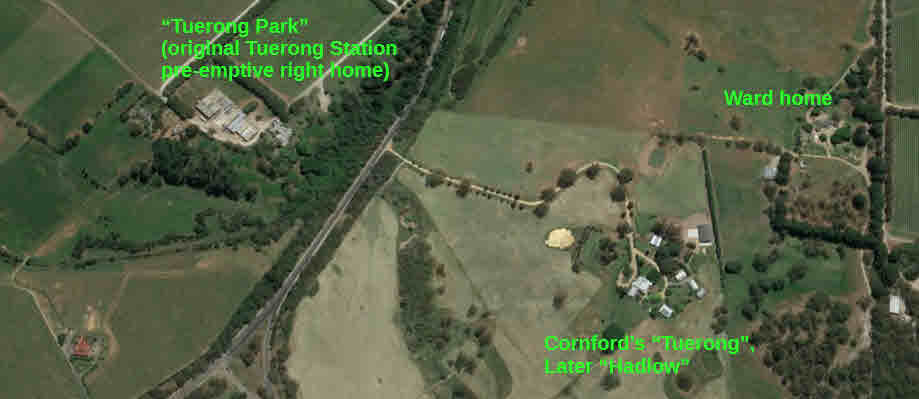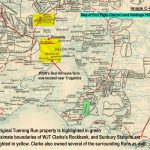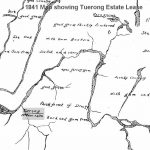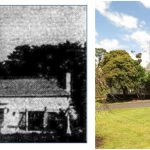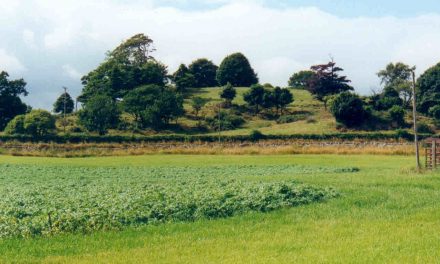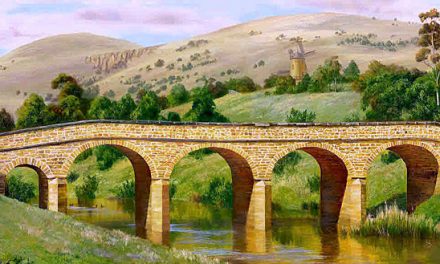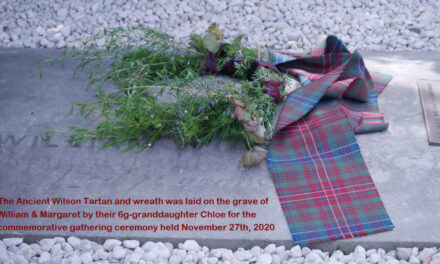Next time you take a drive down to the Mornington Peninsula, just as you enter the freeway proper section of the road beyond Frankston, cast your eye over the gently rolling properties to the left and right – note the rows of vines under the names Dromana Estate, Redhill Estate, Tuerong Estate and others; and beyond the vineyards observe the stud cattle and sheep grazing properties further up the slopes.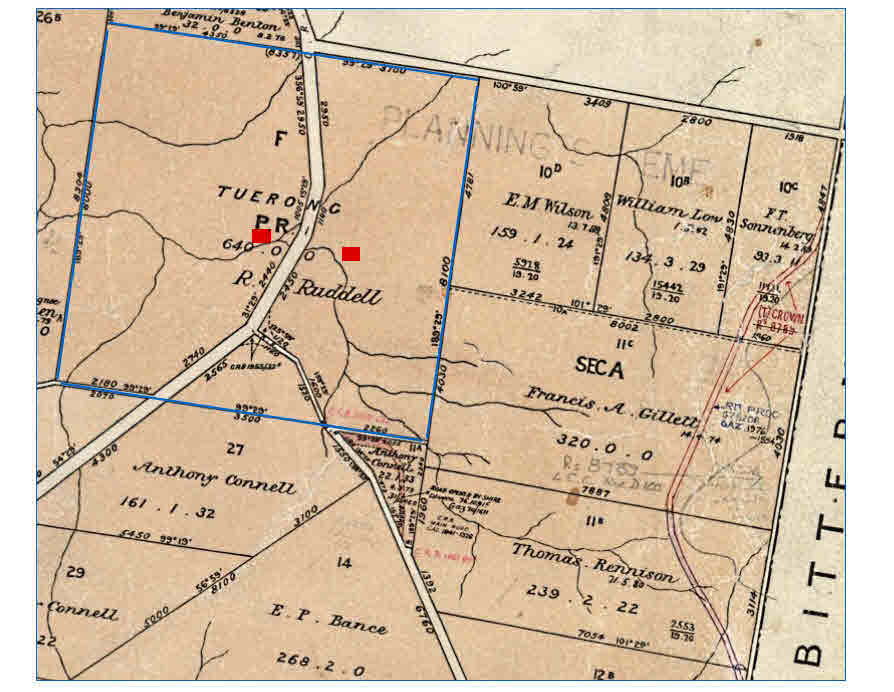
All that you see, on either side of the freeway for some 13 kilometers, when originally granted to one William Thomas in 1840 was known as Tuerong Station, a 25000 acre farming grant whose name was derived from the aboriginal name Teworing. Today it is home to some of the region’s, indeed some of Australia’s, premium brand quality wine vignerons. Early 1860s by government decree the 25000 acres was broken up into one square mile (640acres) lots and sold off by public tender to prospective farmers.
Now, how would you like to own a piece of all that ? – maybe even a measly 1000 acres or so. It turns out that back in the late 19th century ‘we’ did in fact own a significant hunk of it (in fact ‘we’ had 640 acres = 1 square mile = 2.56 sq.km = 2km by 1.3km) – this was part of the standard 640 acre allotments created by subdivision by the Government in 1858.
Shortly after he came back from the goldfields in 1863 John Bowman Wilson purchased this property, with the financial support of his mother-in-law Agnes McDonald (Donne). John called the property ‘Woodlands’ – there is a Woodlands Road running west off Derril Rd near Devil’s Bend Reservoir, into Woods Reserve (Melways 152), but the relationship of this road with the Woodlands homestead and property is unclear. ‘Our’ Tuerong property of 640 acres is highlighted within the blue perimeter in the Survey map above: Tuerong Junction is seen towards the lower perimeter line. The ‘Tuerong P R’ means Tuerong Premptive Right.
John Bowman’s original homestead was close to Tuerong Junction whilst a later home in which John Bowman’s son Albert and his family lived was near the corner of the Moorooduc Highway and Benton’s Lane (small dark blue highlight box in the yellow background image below). Albert’s old home burnt down around 1983, but as at the year 2000 the water supply Well in which two little Wilson boys sadly drowned was still there to be seen. It may still be there today. The Google map in the header image shows the location of the old property now the site of the Dromana Estate Vineyard.
Until recently the Nedlands Lavender Farm occupied a small part of the original 640 acres; it closed down around 2007. We had been told by the Nedland Farm owners that sections of the old homestead which we erroneously took to be John Bowman and Agnes Eliza’s property still formed the central sections of the present home (image below), which had expanded around it through subsequent years and owners.
As we now know from extensive research carried out by local history researcher Peter Ward, this was incorrect and the JBW homestead was an earlier and a much less grand edifice on the other (western) side of the old Moorooduc Road – it goes by the name Tuerong Park Estate whilst the home located on the former Nedlands Farm is called Tuerong. A fuller coverage of Peter’s research may be read on the next article.
It is believed Tuerong Park Estate homestead is located on the site of one of the residences of the first landholder William Thomas – the 1841 hand drawn map identifies Thomas’ site. Study of the creek lines of this old map with the Survey Map supports this being the site of the old JBW homestead. On the Survey Map above, the sites of Tuerong on the eastern side of Moorooduc Road, and Tuerong Park on the western side are marked with small red rectangle ikons.
What might have been, had our forebears had the foresight to hold on to this magnificent piece of property. But regrettably, it needed more than just foresight, since it seems ‘we’ ran into some difficulty with issues of mortgages and insolvency during the 1890s depression which led to a scheme of arrangement taking place between arms of the family.
In the event, property which had been owned by the John Bowman branch seems to have passed under financial arrangement to William Sorell and John Bowman’s son Edwin Wilson, probably a sharefarming arrangement between them. It appears from the official record documents that William who we understand was fairly well positioned financially, helped his brother out of a financial problem albeit on an armslength basis with John Bowman’s son in effect contributing with a labour for equity input. There is also evidence that other of Edwin’s brothers (Albert and Arthur at least) also assisted with labour at the farm.
Various images of the property and location are shown below. The images on this page are compliments of Peter Ward from his yet to be published Tuerong Notes manuscript. A brief historical note on Tuerong from Wikipedia follows below.
- Land Holdings Map 1835 to 1851
- Tuerong – 1841 Map
- Dromana Estate – on the Old Tuerong Home Site
A Brief History of Tuerong from Wikipedia
Tuerong was the name of a squatting run of an estimated 12000 acres that lay between Yuille’s to the north, Balcombe’s, Jamieson’s (Special Survey) and McCrae’s to the west, Coolart to the east and Tuck’s to the south. William Dawson was an early squatter and was followed briefly by Hall and McKenzie and then John Miller in 1850 before Ralph Ruddell obtained the lease in about 1856. He fattened cattle on the lush pastures and had no trouble with water supply because of the network of “never-failing creeks and springs” but became insolvent by early 1861.The Butler and Brooke directory shows that Vaughan and Wild were on Tuerong in 1866-7. The 640 acre pre-emptive right, reduced to 600 acres because of land required for Government roads,became known as Tuerong Park.It is known that J.B.Wilson was on Tuerong Park by 1874 when John and his wife, Agnes, James Firth and John McCusker were all witnesses in the case of the Schnapper Point Murder (which should have been called the Tuerong or Tubbarubba murder.) John died and his widow Agnes died on 27 January 1894 at Tanti Rd Mornington. Later owners of Tuerong Park were: Crook, Pitt, Matthew (approx. 1907 – 1917), Andrews, Dobie, Clark, Moore, Nutchey, Paton (who named one of his racehorses Tuerong), and Edgar (who made it a venue for the polo set in the 1950s).
The Tuerong homestead, built in the late 1800s, is now the restaurant and office of the Dromana Estate at Tuerong Winery. Francis Gillett, grantee of land adjoining Tuerong Park is recalled by the name of a road near the reservoir.He designed Manyung in Mt Eliza and built Sunnyside nearby.(Shire of Mornington Heritage Study P.16.) South of his property was Thomas Renison’s 240 acre grant, where a race meeting was conducted in 1868; when advertised in the Argus on 9-12-1950, it was called “Tuerong Valley” and the quarry was bringing in four pounds a week. Renison owned the Schnapper Point Hotel on the Esplanade in Mornington (The Royal). Other pioneers of the Tuerong area were James Connell, John McCusker and Peter White (whose son in law, John Bourne, later had the same farm for another 50 years.) Old Moorooduc Rd was known for countless decades as Three Chain Rd and was originally the main road to Dromana. The name came about because the road was three chains or 60 metres wide. (Most details come from articles from the Argus found in the National Library’s “Trove”.Details about Rennison and Gillett from the heritage study and the race meeting details from P. 109 of A Dreamtime of Dromana.)

